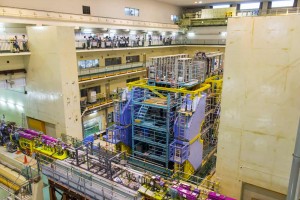On 2 march 2016, electron and positron beams were injected and stably circulated for the first time in the rings of the SuperKEKB accelerator at the KEK laboratory in Tsukuba, Japan. The important milestone, involving the creation of a high luminosity machine, is based on a beam collision scheme developed at the Frascati Laboratories for the Dafne accelerator.
The Frascati National Laboratories are participating in the Belle II experiment mounted along the accelerator, engaged in the development of a new electromagnetic calorimeter as well as data analysis. The group has also implemented and put into operation a scintillating crystal detector system for measuring the background radiation produced by the beams circulating in the SuperKEKB accelerator. It was precisely this system that provided its signals providing instrumental measurements for development of the operating parameters from the first moment of operation of the accelerator.
 INFN-LNF Laboratori Nazionali di Frascati
INFN-LNF Laboratori Nazionali di Frascati
